WORLD CLASS COACHING
Club Curriculum U13/14 Season
By Tony Englund
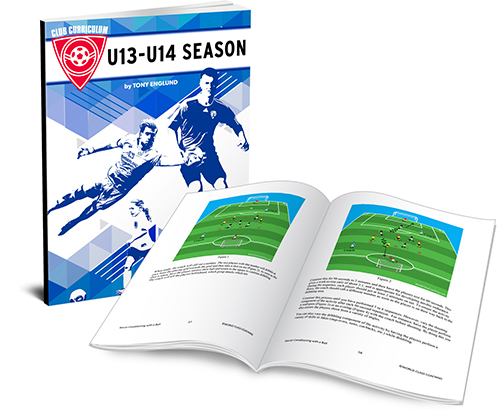
TABLE OF CONTENTS
Part One
INTRODUCTION
SYSTEMS OF PLAY
PASSING AND POSSESSION SESSIONS
Part Two
DEFENDING SESSIONS
Part Three
TECHNICAL SESSIONS
Part Four
ATTACKING SESSIONS
ABOUT THE AUTHOR
Introduction: U13/U14 – Competitive Soccer
The starting point for any adult planning to mentor children is to be certain to adopt the proper perspective in developing a philosophy of coaching that reflects a thorough understanding of the differences between adults and children. Simply put, coaching 13-14 year-olds carries a mandate to continue the technical and tactical development of young players while also nurturing their love of the game.
At U13/U14, the game reaches its full complexity with the move to the big field, full-sized goals and 11 vs. 11 play. State Cup play, forced relegation/earned promotion and a very competitive environment become features of play at U13 and U14, and the differentiation between the elite and competitive teams becomes more pronounced with each successive year. For coaches in these age groups it is important to emphasize the necessity of establishing and then coaching to the needs, abilities and aspirations of the group.
There are numerous studies in print outlining the reasons why children quit playing sports (as many as 75% by age 13). Not surprisingly, those reasons mirror the motivational elements that draw children to participate, as not having fun or improving and not being with their friends are among the chief reasons kids stop playing.
It is thus critically important to strike a balance between continued development, competition and assuring that all players find fun, improvement and at least a measure of success in their experience playing soccer.
Organizing a U13/U14 practice session
One of the most important aspects of coaching is preparation. Players and parents will recognize whether a coach has taken the time to organize his or her thoughts and create an effective, coherent practice plan.
Preparation elements:
• Practice plan: Which exercises will be used and for how much time? What are the key teaching points? The coach should have a written plan for every session.
• Equipment: What types and how many balls, vests, cones, goals, etc. will be needed? Don’t forget a ball pump!
• Safety: The coach should walk the practice area before each session, checking for items that could pose a danger to children. In addition, the coach should carry a phone with emergency numbers for all players. The coach or manager should always have a first-aid kit on site. Lastly, the coach should be the first to arrive and the last to leave training, assuring that there is adult supervision of children at play and that no child is left alone at the field. It is recommended that two adults be present at all times.
Training time: Roughly equal to the length of a game, and generally not more than ninety minutes.
Composition: 1/2 (usually the final portion of practice) of every training session should be spent just letting children play soccer. The remainder of the session is used to introduce and refine skills and tactical understanding through efficient training exercises and games, building toward the final game. It is recommended that the coach choose a theme for each session (i.e. individual attacking, defending or passing and receiving). The curriculum presented in this book can be presented in order and will provide a complete season of training. However, the coach can also pick and choose according to the needs of her team, and much of the material presented here is suitable and designed for repeated use.
Systems of Play: 4-3-3
The 1-4-3-3 formation is a popular, attacking-oriented system of play. This chapter will give an overview of the system, including strengths and weaknesses, group tactical considerations, and key training concepts.
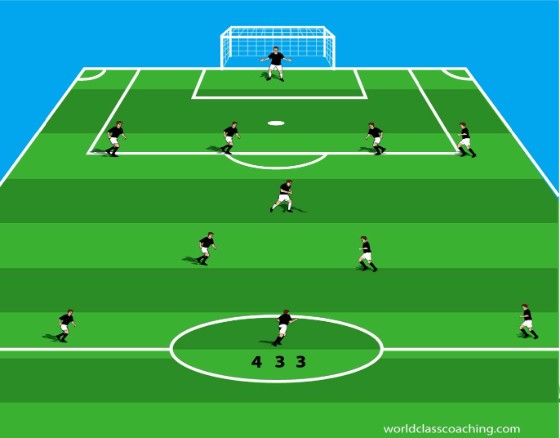
Strengths: The 1-4-3-3 deploys three forwards, giving the team attacking threats high up and in every space in the front half of the field. The three forwards also allow for immediate pressure when possession is lost in the front part of the field, and the forwards should be able to deny the opponent use of their back line to organize possession. This system lends itself well to high pressure defending. If the team plays a triangle midfield, those players will outnumber their opponents when playing against a 1-4-4-2, and the triangle shape allows for considerable flexibility in tactical philosophy for the team (play directly or indirectly; two attacking midfielders and one defending midfielder; one attacking midfielder and two defending midfielders). Finally, despite the use of three forwards, the system still deploys a solid four-player back line, with room for the outside backs to press forward in support of the attack (no outside midfielders).
Challenges: The 1-4-3-3 also presents some concerns for coaches implementing this formation. The use of three forwards means that any pass from the opponents’ back line into their midfield eliminates three defenders (the three forwards). The team assigns 7 players (the back line plus the midfield) to defending, whereas a 1-4-4-2 uses 8). The other major concern is the lack of outside midfielders if the team plays a triangle midfield. At the youth level, many opposing coaches will tell their teams to simply play their outside midfielders when the team wins the ball, and the coach must rehearse with the players the various potential responses to this tactic (typically the near-side back is released to press the ball in the middle or defending thirds, while the near-side forward drops down to pressure in the front third). Finally, transition (particularly for teams playing an indirect style) when possession is won is also a challenge for some younger teams playing this system because of the concentrated and fluid shape of the midfield, and the coach must spend some time working with the back line to assure that they understand how to connect to a checking midfielder or forward.
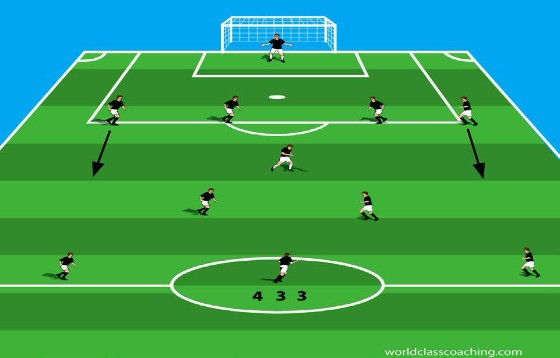
Tactical Considerations: In most 1-4-3-3’s, the back line is a standard, flat back grouping. It is helpful, because of the space in front them in the 4-3-3 if the midfield is shaped as a triangle, if the outside backs are quick, skilled players who can get forward in support of the attack. The two center backs usually stay home, but they should be accustomed to supporting and connecting with the midfield group. The goalkeeper, incidentally, should be a skilled distributor of the ball who can play over distance (goal kicks, punts, throws), as most teams playing this system like to get the ball to one of the three forwards as soon as possible when possession is regained and at restarts.
The midfield in the 1-4-3-3 can be arranged as a flat grouping (increasingly rare) or in a centrally-condensed triangle. The flat arrangement is less common because the team must have a spectacular central midfielder to deal with opposing central midfielders (usually 2 or 3 players). The triangle arrangement, which is flexible, common and very effective at any level, features either one attacking midfielder and two defending midfielders or vice-versa. These players often interchange roles and positions, and the coach should nurture both tactical creativity and discipline into the group.
The front line arrangement is also fairly standard, with a central forward and two wing forwards. The most common considerations here are which position(s) drop in to aid in defending and transition. The advantage of the center forward dropping in is that the team has 4 players in the central space in front of the defense, a formidable block and also a springboard for counter-attacks. However, this posture means that opposing center backs have little pressure in possession. If the wing forward(s) drop in, they can help defend the flank spaces in the midfield, but they also are in poor positions to exploit the flanks once a counter-attack has begun. Many coaches just drop the forward nearest to the ball back into the defending block, a simple and often effective tactic.
Systems of Play: 4-4-2
The 1-4-4-2 formation is the most common of the U13+ tactical layouts in today’s game. This chapter will give an overview of the system, including strengths and weaknesses, group tactical considerations, and key training concepts.
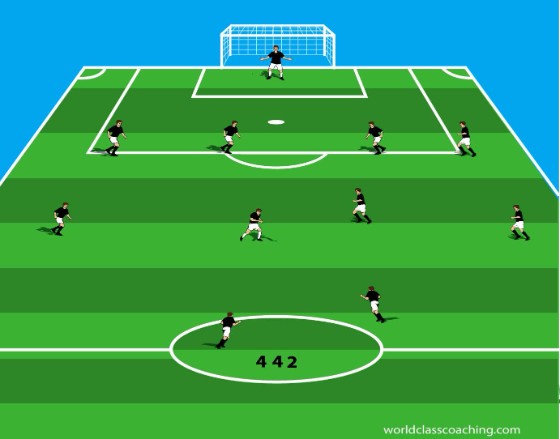
Strengths: 1-4-4-2 allows for a strong defensive bloc, with 8 players (plus the goalkeeper) committed to defensive work. This system is a smooth transition for U11-U12 teams moving on to the big field after playing 1-3-3-1, as a player is simply added to each of the defensive, midfield and front lines. This system is also easy to teach, as the areas of the field can be subdivided evenly and manageably among the players in each group, and passing relationships are easy to define. Finally, as outlined below, the midfield and back line can be deployed in different ways to highlight the strengths of the individual players and team.
Challenges: 1-4-4-2, like all systems, also has some inherent weaknesses. First, two forwards can become isolated and provide insufficient punch in the attack. For some teams, the two forwards can expend a lot of energy chasing the opponents’ back line without winning many balls. Teams that play 1-3-5-2 will have an extra player in the midfield and still have a numerical advantage on their backline as well. The most common criticism of this system is that it is inherently defensive, and the coach will need to address how the team will get sufficient numbers forward to create and sustain attacks.
Tactical considerations: Both the back line and the midfield can be deployed in different ways to support player abilities and team tactical goals. The back line can be played “flat” with two center backs and two outside backs (see below). This layout requires a zonal philosophy be adopted for defending. In this arrangement, the center backs in particular need to be well versed in balancing one-another’s actions (i.e. when one steps up, the other covers), and players need to learn to focus on dealing with a particular space rather than a single opponent. Additionally, the goalkeeper must be able to deal with the space behind the defense by cutting out through balls in particular. The advantages of adopting a flat back line include the ease of providing a broad, stable line for organizing possession and, relatedly, because the players are organized to track space rather than individual opponents, their shape will facilitate predictable transition.
The other method for organizing the back line is referred to as a diamond shape. In this case (see below), the two central defenders are staggered, with a sweeper (deeper back) and a stopper (who sweeps in front of the defensive line). This arrangement is simpler and builds in depth, but is less useful, generally speaking, for transition to possession and attacking, and can be torn apart (if the front two or three man-mark) by intelligent attacking. The sweeper is typically the organizer and a very strong tackler, as well as a mobile player who long passes well and is strong in the air. The marking (outside) backs are often fast, tough 1v1 players who can isolate and strip opponents on a consistent basis. The stopper is frequently a strong, decisive tackler who serves as a wrecking ball for opponent’s attacks. She is typically also very strong in the air and, ideally, serves as an organizer as well. Either of these layouts can work, and each has its advantages and weaknesses. Certainly the flat back line, if practicable with a team’s talent, is the desirable and more sophisticated organization for U14+ teams.
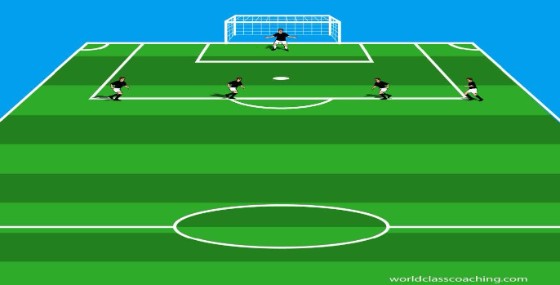
The midfield organization for classic level teams is typically fairly straightforward, with a pair of inside or central midfielders and a pair of flank or outside midfielders. The flank midfielders are typically players who excel in space for speed reasons and it is helpful if they can get end line and cross with consistency. If the team plays a diamond back line, the outside midfielders have important defensive responsibilities in dealing with space outside of the marking backs. The central midfielders are the organizers (the “engine”) of the team. They need to be technically-sharp, hard-working and intelligent players who communicate and organize the team’s attack as well as providing consistent defending presence in front of the backline. Many coaches like to stagger the two central midfielders, with one playing as a holding player and the other pushing forward behind the strikers.
The two strikers in a 1-4-4-2 are most often deployed in a staggered pairing, with the ball-side striker acting as a target underneath while the other striker stretches the line of the defense. Most coaches prefer that the two strikers work to stay within 15 yards of one-another so that they can provide constant support in transition. Finally, most striker tandems feature one very fast player and one physically-dominating player. The former tries to get in behind defenses and the latter is usually a target on crosses.
Systems of Play: 1-3-5-2
The 1-3-5-2 formation is increasingly rare in today’s game. Many coaches find that three backs are too easily exposed at higher levels. However, some coaches still enjoy the five-player midfield arrangement, and this system is popular with coaches who like to hold the ball in the midfield. This chapter will give an overview of the system, including strengths and weaknesses, group tactical considerations, and key training concepts.
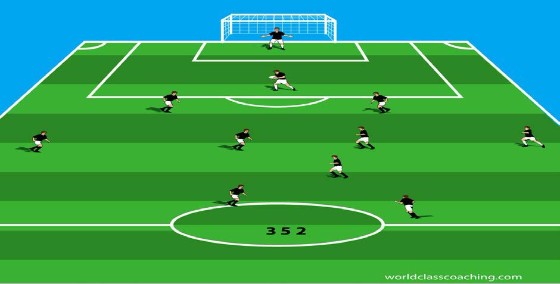
Strengths: The 1-3-5-2 features a very flexible and often powerful 5-player midfield. Often, the flank midfielders are very fast, talented attacking personalities. The attacking midfielder(s) also often join the attack, and they must connect with the forwards in possession.
Challenges: The three back is often beaten by teams that play directly and play into open space on the edges of the back line. For this reason, the outside midfielders can often be forced to adopt deep starting positions (while they help out on defense), limiting the formations attacking numbers and ability to develop width. The two forwards may be unable to provide consistent pressure on the opposing back line.
Tactical Considerations: If the coach opts to utilize this system for the team, then the team must become accustomed to controlling the middle of the field on game day. The center midfield triangle must feature players who can control that space and dominate in possession. The flank midfielders must possess very good fitness and speed and be able to play end line to end line, serving crosses in attack and covering the space outside of the back line when needed on defense. The back line players must be very mobile and disciplined, controlling central spaces and winning duels when isolated. The forwards work in tandem to provide pressure on the defensive side of the ball and to serve as targets in attack. They should remain within 15 yards of one-another, always looking to play a two-person game to get in behind. They also need to work well with the central midfielders in possession and combine well with the flank midfielders.
Training Session# 1: Advanced Technical Passing
Introduction: This session introduces rhythm passing in a group setting, providing a number of challenging and fun environments in which players learn to work together under time and then opponent pressure.
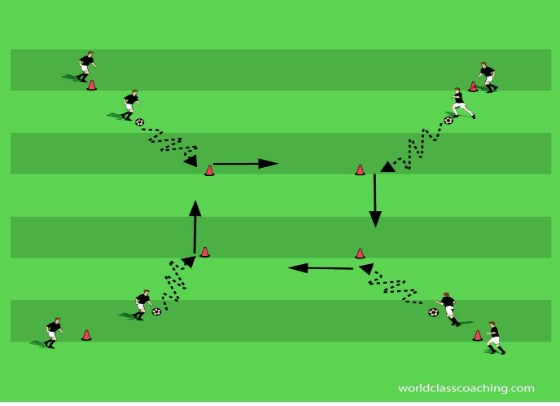
WPS Square - 15x 15 yard grid
Players and a ball at each corner of the larger grid. The first player in each line dribbles in and stops the ball at the nearest cone. The players then run along the perimeter of the smaller grid and pass the ball at the next cone to the first player at the cone the nearest line and join that line. It is critical that players develop a sense of unified timing to make this exercise function well.
Variations:
• players dribble the ball to the nearest cone and then run diagonally across the grid and pass the ball waiting there to the first person in the nearest line before joining that line. This variation compels players to deal with traffic as they move across the grid.
• players dribble the ball to the nearest cone and then run diagonally across the grid and pass the ball to the first person in the nearest line. This target player should be waiting 3 yards behind the cone and to one side of the cone. The passer then moves to the opposite side of the cone and the runner works to complete a 1-2 with the target, who then dribbles the ball to the inside cone and play continues. Once again, a sense of timing as well as technical precision is important to the success of the exercise.
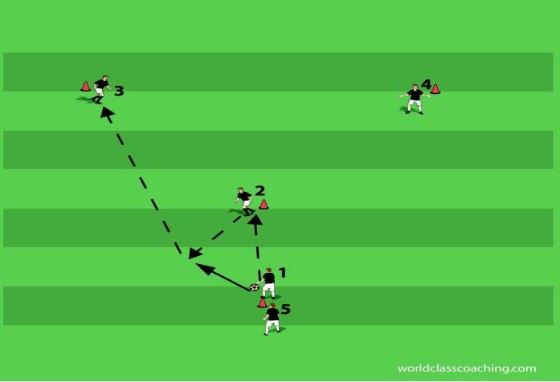
Y Drill - 10x12 yard areas
Player 2 checks away from the ball and then back toward player 1. Player 1 passes to player 2, who lays the ball off at an angle to player 1. Player 1 then passes in to the feet of player 3. Player 3 dribbles at speed back to the start point and leaves the ball for player 5 to commence the next sequence (to player 4’s side of the grid). As the players develop rhythm in the passing, encourage them to play 1-touch as much as possible. Players move up one cone with each sequence.
Variations:
• when the ball is played to the top of the ‘Y’, the receiving player plays first-time back to the start point.
• player 2 checks away and then checks back to the ball. Player 1 passes to player 2, who returns the ball first time. Player 1 then passes into the feet of player 3 and follows her pass. Player 3 plays a 1-2 with player 2 around player 1’s run.The players each move up one cone as the ball is passed by player 3 to player 5 at the start point of the exercise. Play continues and the sequence is run to player 4’s side of the grid.
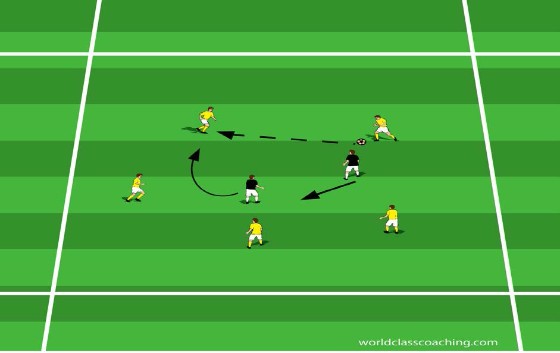
5v2 - 10x10 yard areas
Two defenders at the center of a circle formed by 5 attackers. The attackers attempt to keep possession through 1 and 2-touch passing. The defenders attempt to gain possession of the ball or knock the ball out of the circle. The attacker who loses possession for her team changes place with the defender who caused the turnover. This is a commonly used possession exercise with many useful variations.
Variations:
• after passing, players must move to a new part of the circle. This requirement both gets players moving after a pass and also compels the attackers to continually reform passing angles by adjusting the circle.
• require the attackers to shrink the circle as they play. This variation applies added to pressure to the attackers as they attempt to keep possession.
• run two circles and have the defenders cross over to work in the other circle. The attackers count their passes nd work to get the highest single score. Rotate the defenders every minute to provide high pressure.
8v8 Game - ½ field
Play 8v8 on ½ field. Allow the teams to play for a few minutes and then utilize the following restrictions for 5 minutes each before returning to unlimited play.
• require a 1-2 before a shot on goal with each possession.
• 2-touch play.
Session# 2: Advanced Technical Passing 2
Introduction: This practice continues the theme of rhythmic group passing, adding new environments and small-sided games designed to produce increasing confidence and technical proficiency.
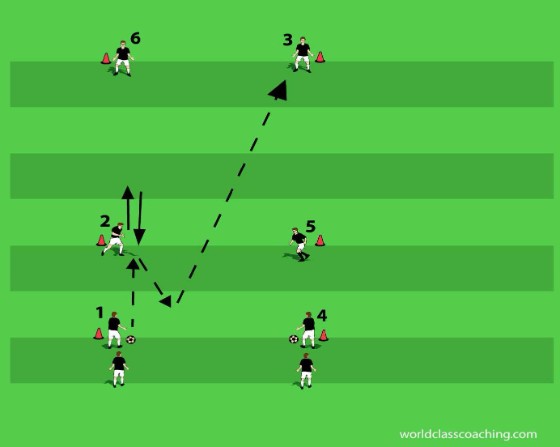
Rectangle Pattern Passing - 15x25 yard area
Player 2 checks away and then back to the ball. Player 1 passes to player 2, who lays the ball off toward the inside of the grid for player 1. Player 1 then passes into the feet of player 3. Players 1 and 2 move up one cone in the sequence while player 3 dribbles the ball at speed back to the starting point. Meanwhile, the exercise is repeated on the other side of the grid. As the players become more comfortable, encourage them to play one-touch where possible and at speed throughout.
Variation:
• player 2 checks away and then back to the ball. Player 1 passes to player 2, who lays the ball off toward the inside of the grid for player 1. Player 1 then passes into the feet of player 3. Player 2 shows to the inside of player 3, who plays a 1-2 with player 2 before continuing back to the starting point. As with the base exercise, players move up one cone with each sequence, and they should play at speed and with minimal touches as they become more accustomed to the pattern. Finally, advanced teams can use the check run by the initiating player on one side as the passive defender for the 1-2 from the other side of the grid.
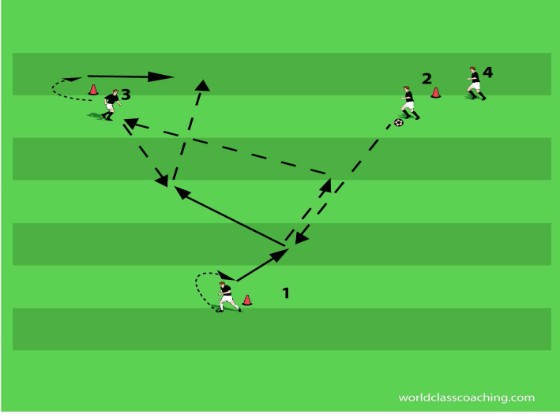
Triangle Passing - 15x15 yard area
Player 1 checks away and then back to the ball. Player 1 passes to player 2. Player 2 lays the ball off for player 1 to run onto and then spins off to the outside. Player 1 plays into the feet of player 3 and then moves ahead one cone. Player three lays the ball off for player 2 to run onto and then spins off and player 2 plays into her path before moving ahead one cone. Player three dribbles the ball to the start point for player 4 and the sequence repeats. This exercise builds speed, running off of the ball, communication and sharp one-touch play into a team. It also helps players become accustomed to playing together in a fast-paced pattern play environment.
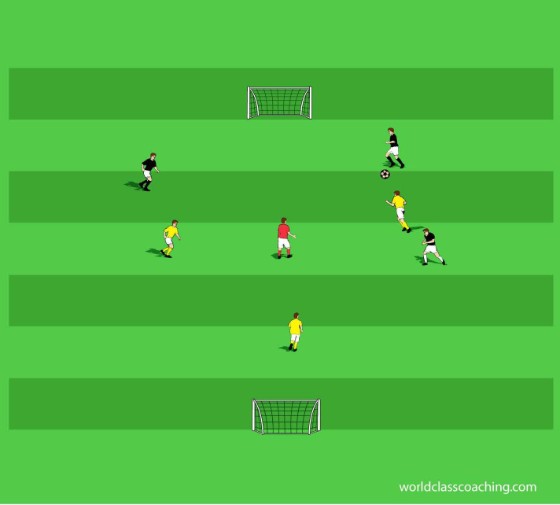
3 vs 3 +1 Small-sided Games - 20x25 yard fields
Play 3 vs 3 with a neutral attacker to small goals. Allow the players to scrimmage for several minutes before stopping to emphasize the importance of utilizing the neutral player in possession to maximize numerical advantage. Additionally, running off the ball, one-touch play, and combinations should all be points of concentration (require combinations before a shot for a portion of the scrimmage).
7v7+2 (becoming 8v8) Scrimmage - ½ Field
Play 7v7 with goalkeepers and two neutral attackers on ½ field. Once again, the emphasis should be upon pinging the ball around in possession and exercising one-touch play, combination play and running off of the ball. After 15 minutes, switch to an 8v8 game with goalkeepers, being careful to continue to reinforce the themes of the session.
Training Session#3: Turning
Introduction: Turning is one of the least taught, yet most critical skills. Players must be comfortable and efficient making good decisions as to whether they can immediately face up to their opponents and the goal or if they must move to shield the ball with their first touch. This session provides multiple environments and ideas designed to help players think quickly and develop several options for turning in game situations.
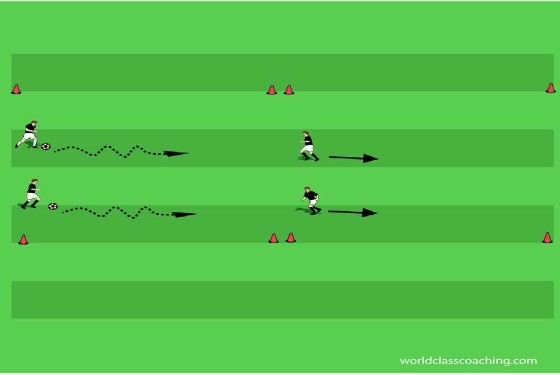
Touches and Turning - 26x26 yard grid
Players work in pairs with one ball. The grid should be divided in half to create a pair of thirteen yard wide grids. One partner, with the ball, stands on the edge of the grid. The other partner stands where the grids meet (see diagram). There are two variations of this exercise, the first of which is a warm-up and the second of which introduces the turning topic.
• the player with the ball dribbles toward the center of the grid taking one touch for every step. This player should work hard and work fast to get to the center. Her partner backpedals to the edge of the grid on her side. When the dribbling player gets to the center, she passes the ball to her partner and their roles reverse. Play for two minutes.
• in the second variation, the player with the ball passes immediately to her partner in the middle of the grid. As she plays, she instructs her partner to, “Turn!” The receiving player gets “shoulder on” (turn one shoulder to point at the passing player. In this way, she is already half-turned) and receives the ball with the inside of the foot farthest from the server. She then turns and dribbles to the edge of the grid. Meanwhile, her partner sprints to the middle of the grid and their roles reverse. Instruct players that the running player who is checking to receive should time her run so that she is not waiting for the ball when it is played. Also, the turning player should alternate the shoulder she turns to the passer so that she can practice receiving with either foot. Play for three minutes.
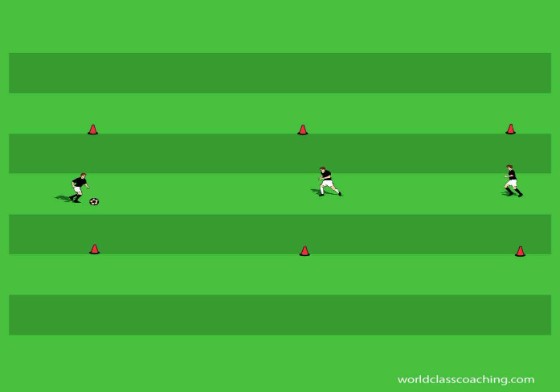
Carolina Turning Series - 12x20 yard grids
Players work in groups of three with one soccer ball. There are many variations of what is often called the “Carolina turning series.” Here, the purpose is to introduce the basic format and simple turns for players learning to make good decisions in possession. Four turns are outlined below. To begin, the moves are performed without pressure. The working player needs to be instructed to check her space throughout the series. This is accomplished by taking a sharp look over her shoulder during the checking run. Each player should take a turn in the middle practicing each turn for one minute and at speed.
• front foot turn. This is the turn outlined in the warm-up exercise. Here the player decides that there is no pressure, gets shoulder on and receives with the inside of the foot farthest from the server. Once turned, she takes a dribbling touch and delivers the ball to the third player on the far end of the grid. The end line players need to be consistent in making the early command: “Turn!” Require the working player to alternate the receiving foot.
• man on. In this case, the receiving player is operating under the pretense of pressure. Therefore, in making the checking run to the ball, she prepares to receive the ball with the outside of the foot nearest to the server. This touch puts the working player into a shielding position with her first touch. The passer hollers, “Man on!” with each serve. Once the working player has controlled the ball, the passer hollers, “Back!”. At this signal, the working player passes the ball back to the server. Note: The passer should get into the habit of changing the angle of the back pass by sliding left or right while calling the ball back. This adjustment will serve the players well when they get into this situation on the big field in that the change of angle requires the defense to adjust their pressuring runs, and new passing angles are created immediately for the team in possession. Note: For this “turn” only, a second ball is required (that is, each of the endline players has a ball).
• self-pass. Here the working player again operates under the pretense of pressure. Instead of shielding and back-passing, though, the working player “self-passes.” In essence, this amounts to the working player getting into a shielding position, but instead of a shielding touch, she uses the outside of the foot closest to the server to take a longer touch (typically about a yard or a bit longer). The purpose of this touch is to create separation from the defender. The working player then runs sharply back around the ball to face up with the defender and takes a couple of touches before delivering the ball to the end line player on the far end of the grid. This turn is extremely useful in particular for quick, agile players (often on the flank) who can use their speed to get separation from the defender and then face up to create favorable 1v1 dueling situations. Instruct players to alternate the foot they use to make the self-pass.
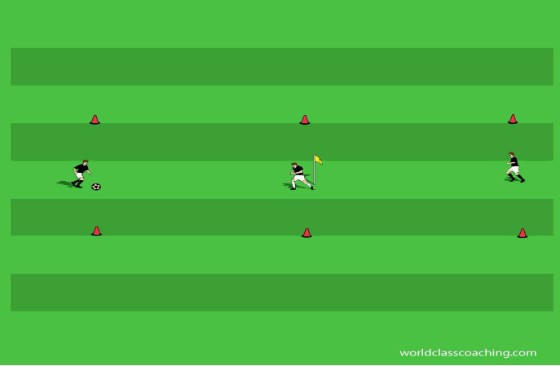
• screening the defender. Place a flag at the middle of the area as shown. The working player checks away behind the flag and then back where she ‘posts up’ on the flag (which acts as a passive defender), showing with her hand at her side where she wants the ball passed. Using her body, she screens the defender from the ball (without touching the ball as it runs past) and then runs onto the ball. Be sure to work both sides.
Once the turns have been performed in isolation, complete a second round of practice. Add a semi-passive defender, who gives some pressure without trying to win the ball.
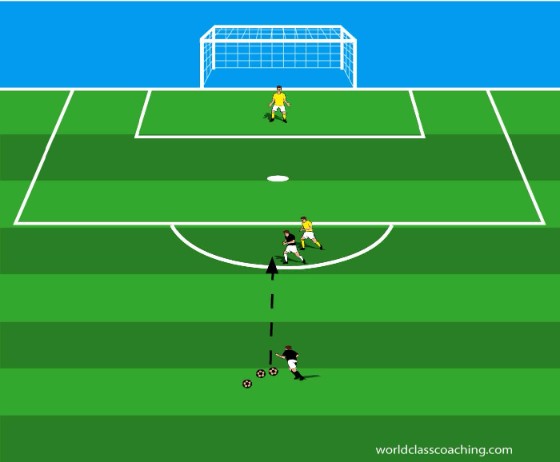
1v1 to goal with turning emphasis - 1/3 field
Collect balls centrally and twenty-five yards from goal. An attacker and a defender begin in the “D” as shown. The attacker checks to receive a pass from the first player in line. Instruct defenders to vary their initial pressure so that the attackers can learn to think their way through their turning options. Play is live until the defender touches the ball or the ball leaves the area (i.e. through a goal or shot at goal). The easiest rotation is passer becomes attacker; attacker becomes defender; defender retrieves a ball and gets back in line.
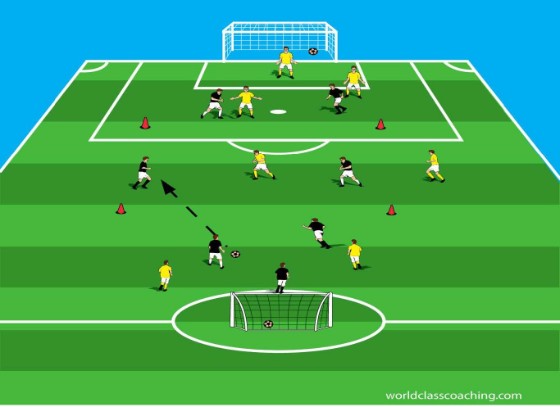
3-zone game - 25x45 yard field
Play 7 vs. 7 on a field divided into three 20x30 yard zones (see diagram). This game can be played to full-sized goals or to small goals, depending upon the numbers available. The teams place two defenders (and a goalkeeper if possible) in their defensive third; two midfielders in the middle third and two forwards in the front third. Explain to the players that for the first part of the game, they are locked into the zones where they are placed. This restriction is designed to compel players to play the ball forward, creating situations where the players can practice both the communication and technical execution of the turns introduced above.
The coach will need to encourage target players in the zones ahead of the ball to avoid lingering at the near edge of their zone, waiting for the ball. Instead, they need to be disciplined about creating space by remaining well away from the ball and then checking in to receive when supporting players are prepared to play to them. The other important coaching point that often needs emphasis here is the advantage gained by checking in at an angle to the ball. A player checking in at an angle is a much easier target to find and play accurately to than a player coming straight on to the ball.
After ten minutes, introduce a new rule: Allow a player who makes a successful pass into the zone directly ahead to join the attack in that zone. This will help build possession as teams can get an advantage in numbers by playing intelligently. Also, point out to players that they can play back to the zone behind them if they receive the ball under pressure and in this way the team can organize possession and create more service to target players in the next zone. Note: When possession is lost, any players who have worked their way forward must return to their original zone. Remove the zone limits for the final ten minutes of the scrimmage and let the players play.
Training Session# 4: Combination Play – 1-2’s.
Introduction: This practice includes a number of exercises designed to help players improve their understanding, touch and running off of the ball in situations where a quick 2-1 combination can create attacking space for the team.
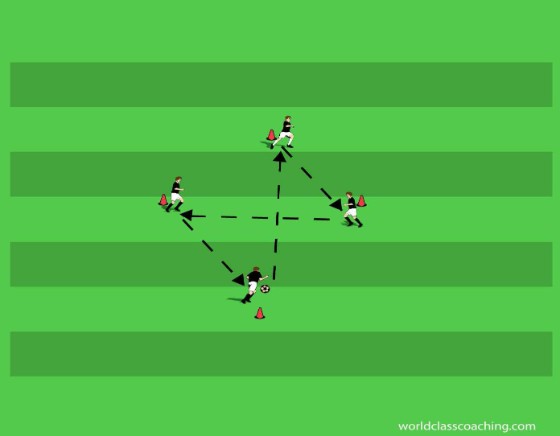
Diamond Passing 1 - 10x10 yard areas
Players pass and follow as indicated with an emphasis on quality technique in both passing and receiving. Passes should be to the foot of the target that is on the side where the player will play next and the receiver should prepare early to receive.
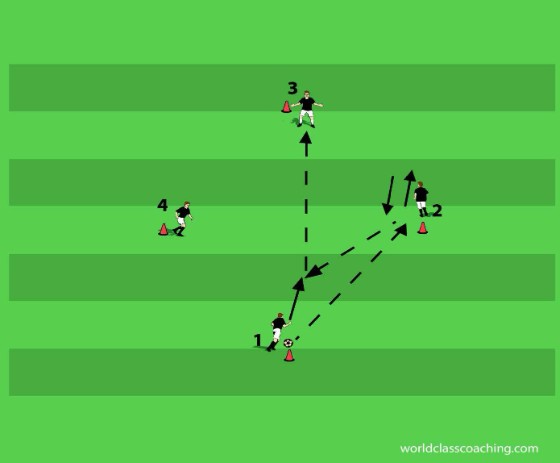
Diamond Passing 1-2’s - 10x15 yard areas
Player 2 checks away and back to the ball. Player 1 passes in to the feet of player 2. Player 2 lays the ball off backward and inside for player 1 to run onto and pass into the feet of player 3. Player 1 and player two each move up one cone. Player 4 checks away and back to the ball and the sequence continues back to the starting position.
Variation:
• player 2 checks away and back to the ball. Player 1 passes in to the feet of player 2. Player 2 lays the ball off backward and inside for player 1 to run onto. Player 2, meanwhile, has spun off away from the ball and is running into space behind her starting cone. Player 1 takes a touch and then plays a through ball onto the feet of player 2, who touches the ball on to player 3. Player 1 and player two each move up one cone. Player 4 checks away and back to the ball and the sequence continues back to the starting position.
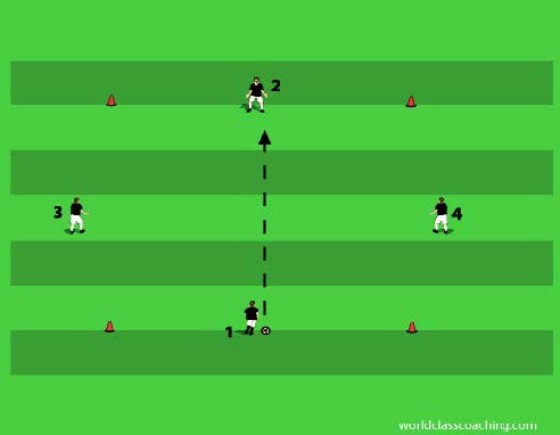
1v1 +Attacking Bumpers - 10x15 yard grids
Player 1 passes into the feet of player two and the two players duel. Each player attempts to win the ball and dribble over her opponent’s end line. The player in possession can use the side bumper players to attempt to play 1-2’s to get in behind the defender. The side bumpers are limited to 1-touch, and cannot play each other, but they can move up and down the sides of the grid.
When the ball leaves the grid, the active players become bumpers and the bumpers become the active players. In this exercise, encourage the attacking player to learn to engage the defender, forcing that player to set her feet. At that moment, either bumper can be used to create the 1-2. Note: It is not required that the bumpers be used, as play can become too predictable.
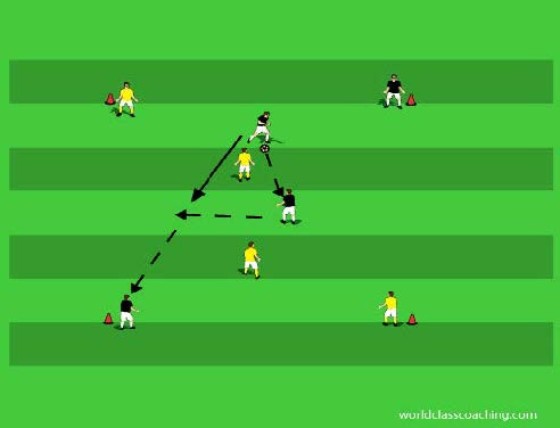
2v2+4 - 12x12 yard grids
Play 2v2+4, with each team having a pair of diagonally-placed corner targets to play to. Players who pass into a target take that player’s spot, while the target quickly dribbles into the grid and works with the remaining teammate to try to get the ball to the other target. This is an outstanding environment for training on 1-2 combinations, as the numbers, speed and space all force players to step, think and play quickly.
8v8 Scrimmage - ½ field
Play 8v8 on ½ field. Play without restrictions for the first phase of the scrimmage. Then require a 1-2 before a shot at goal. Finally, remove the restriction but encourage the players to find 1-2’s where they can inside of the run of play.
Training Session# 5: Combination Play – Overlap
Introduction: The overlap is one of the most fundamental and useful methods for eliminating defenders and creating space. This session introduces a number of very efficient and increasingly challenging environments wherein players can learn to recognize and execute overlapping situations.
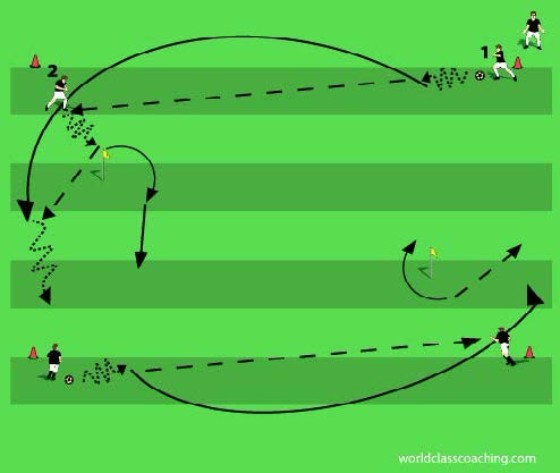
Overlap Machine - 20x25 yard area
Player 1 passes to the feet of player 2, who dribbles at the cone (representing an unsupported defender). Player 1 calls, ‘hold!’ and makes an overlapping run behind player 2. The latter slows her run to hold the defender and then plays in behind to player 1 completing the overlapping move. This sequence is practiced in both directions. Emphasize speed and accurate communication and passing. Players should change roles with each sequence.
Progression:
• player 1 passes to the feet of player 2, who dribbles at the cone (representing an unsupported defender). Player 1 calls, ‘hold!’ and makes an overlapping run behind player 2. Player 2 holds the ball and slows her dribble. Rather than playing the direct through ball, player 2 turns her hips (toward the runner) to fake the direct pass, and then sharply cuts the ball toward the inside of the grid and past the defender. Then the pass to the overlapping player is completed after the defender is played out.
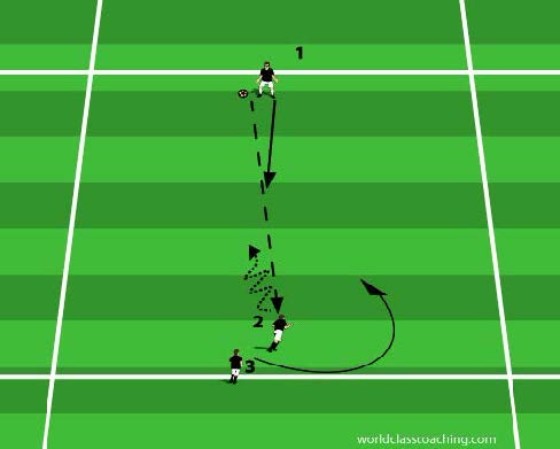
1v1 Plus Overlapping Attacker - 10x15 yard grids
Player 1 duels with player 2 with both players attempting to dribble over their opponent’s end line. Player 1 passes to player 2 and moves to defend. Player 2 can try to beat player 1 on her own, or if she holds the ball, the next waiting player can call ‘Hold’ and attempt to overlap the attacker to get to the end line. Emphasize to the attackers that the run can be used as a decoy (i.e. the attacker looks to the overlapping player then sharply cuts away to get end line on her own). Players change ends after each duel.
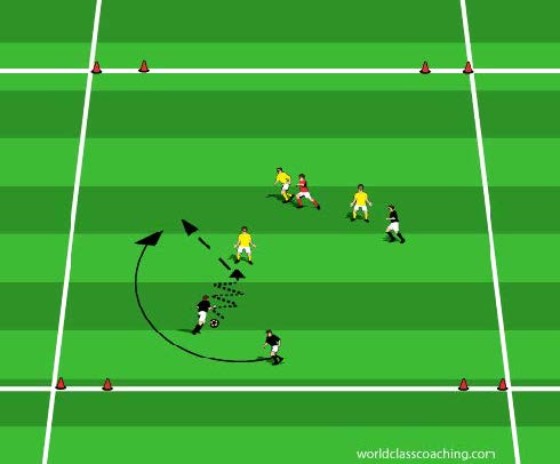
3v3+1 to Corner Goals - 20x30 yard area
Play 3v3+1 in a 20x30 yard area to corner cone goals. Because the numbers are small and the goals are in the corners on a wide field, this is a good environment in which to train on overlapping combinations. Require each effort to score to be set up by an overlapping run. Encourage teams to be patient and possess the ball in the middle of the field to set up flank overlapping. Also, if the overlap is not on (i.e. the defenders arrive in numbers or the attackers run out of space), emphasize that possession should be maintained and the direction of the attack changed.
8v8 Scrimmage - ½ field
Play 8v8 on ½ field. Arrange the teams to keep numbers on the back and midfield lines (i.e. 1-3-3-2) so that overlapping runs can be built in and encouraged. Require an overlapping run to precede an effort at goal for the middle portion of the scrimmage, with open play to begin and end the game.
Training Session# 6: Possession
Introduction: This practice opens with a review exercise targeting players’ passing accuracy and their ability to produce a consistent, quality first touch that will allow them to move the ball with their second touch. The session also includes two popular and challenging team possession exercises.
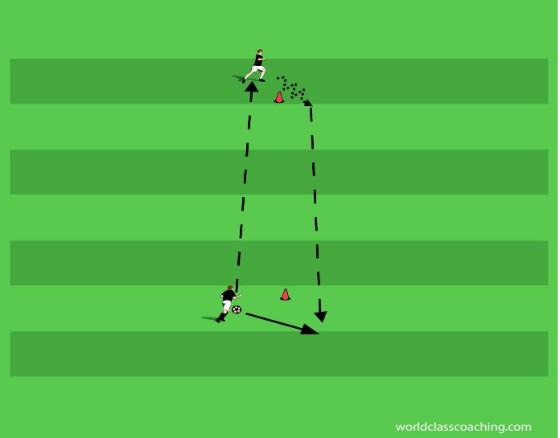
Pairs Dutch Passing - 10X5 yard area
Players work in pairs with two soccer balls. The players work to pass and receive the two balls at the same time. Both players pass with their right foot and receive with their left foot. The change of feet and the common passing lane compel the players to work very hard to sharply change the angle on the ball with their first touch, a mandatory consideration in tight space and to prepare the ball to be released in two touches.
Variations:
• players pass with their left foot and receive with their right foot.
• players track the number of passes they make in one minute. Check scores to see which pair completed the most passes. This competition adds time pressure to the technical demands of the exercise.
• one player passes the ball on the ground while the partner lifts their ball with their laces and flicks the ball to her partner. The player receiving the lifted ball works to receive and settle the ball quickly and the sequence is repeated. Change roles after one minute. Count the number of completed passes and compare scores.
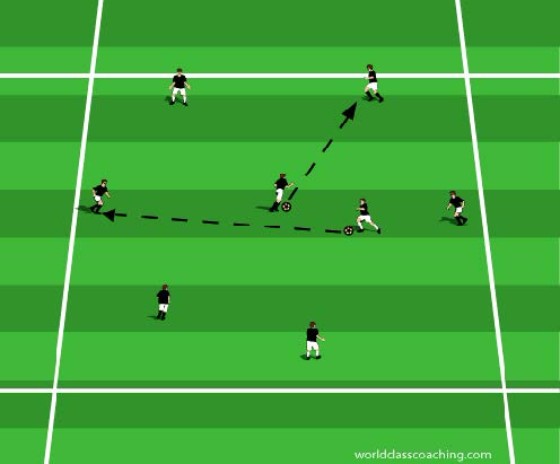
Two-ball Circle Passing - 15X15 yard area
Form two groups of seven players. Each group has two soccer balls. Two attackers with balls stand at the center of each group. At a signal from the coach, both players pass their balls to players on the outside of the circle. They then move to receive the other ball from a player on the outside. Outside players do not play to one-another, but do call to the players inside to connect verbally and visually before passing. Players are encouraged to work very quickly (one and two-touch play) and to work on their turning in particular. Perimeter players are required to call ‘turn!’ after each pass to a central player. Rotate the middle players every minute.
Variations:
• after passing to a central player, each outside player must sprint to another position along the perimeter of the circle. This requirement compels players to be active after releasing the ball and to also continue to adjust their shape along the perimeter.
• outside players can call, ‘man on!’ when playing inside. If this call is made, the receiving player receives with the outside of the nearest foot to the server (shielding touch) and returns the ball to the server.
100 Passes - ½ field
Form two even teams. The coach serves balls into play for restarts. Each team counts their passes. The first team to reach 100 passes wins.
Cone Drop - 40X40 yard grid
Form three teams (yellow, blue, red). To begin, the reds will be neutral targets for a game between the yellows and the blues. Each red player gets three blue cones and three yellow cones. The reds are limited to one touch and cannot move, but also cannot be tackled. Each time a red target is played, she drops a cone corresponding to the color that played her. The first team to get all of their color cones on the floor wins. This game effectively creates an overload possession environment while still requiring some thought in the variations outlined below in particular. Rotate the targets after each game.
Variations:
• targets out of cones can demand the ball from players and if they are played, they pick up all of the cones of the corresponding color. This restriction requires passing players to think carefully about their choice of pass.
• target players can walk about the grid.
• target players move about at full game speed.
8v8 Game - ½ field
Play 7v7 with goalkeepers. For the middle portion of the scrimmage, offer a point for 6 consecutive passes by either team. Otherwise, the scrimmage is open play with an emphasis on possession of the ball.
Training Session# 7: Possession – Speed of Play
Introduction: After technical proficiency and tactical intelligence, one of the most critical factors in team success is speed of play. The term refers to the efficiency with which a player, and then a team, can execute successful cycling of the ball in the attack. This session looks at the tactical efficiency of the team in possession through unopposed movement of the ball with challenging restrictions and then puts the team’s ability to play at speed to the test through small-sided play in the open field and also around the goal.
Two-team unopposed possession - ½ field
Create two equal teams. Explain that each team will have two soccer balls to begin and that the two teams cannot interfere with the other team’s balls, though the players must intermingle throughout the exercise. Explain also that the current session is designed to increase individual and team speed of play. That speed of play encompasses technical speed, tactical speed and physical speed and the players must work throughout to increase their ability to play the game quickly with and without pressure.
Progression:
• both teams knock their two balls around without restrictions.
• after passing, players must move to another ¼ of the field.
• after passing, the players must sprint to another ¼ of the field.
• players must check away before checking to the ball to receive (to create space).
• players must call the name of the player they will pass to before they pass the ball.
• players must call the name of the player they will pass to before they receive the ball.
• 2-touch limitation
• 1-touch limitation
Note: Except where the new restriction cancels the previous requirement, the previous requirements remain in place as play continues.
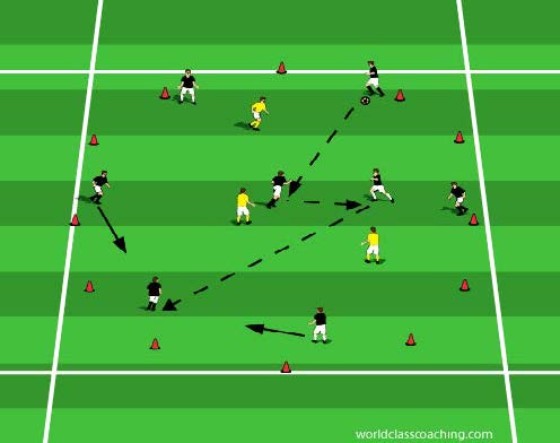
German Ellipse - 10x20 yard ellipse
Create two equal teams. One team begins in the ellipse as shown. The other team provides three defenders and the remainder of the players serve as ball retrievers (rotate defenders every two minutes to get high pressure). The attackers are evenly distribute around the ellipse, with two or three central players (usually central midfielders) in the middle. A resting player from the defending team serves balls to the attackers for re-starts. The attackers attempt to keep the ball in the ellipse and in their possession.
When the defenders win the ball, they kick it out of the ellipse.
Progression and coaching points:
• insist that players move toward the ball as they play, particularly if there is pressure. At first blush, this seems counter-intuitive because we always encourage players to create space and a release, but there are times when we do need to play in very tight space and more players create more options as long as the speed of play is such that the defense cannot get set and contain the ball.
• attackers count passes and the two teams compare scores after each team works in possession for 5 minutes.
• attackers are encouraged to play through their central players. Award an extra pass for each touch by a central player.
• to encourage central players to find one-another under pressure, reward an extra pass point when one central player plays another.
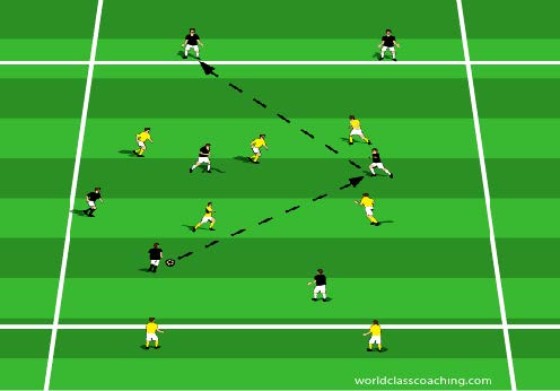
End line Targets - 50x70 yard area
Create two equal teams. Each team places two targets on their opponents’ endline. The coach has a ball supply for re-starts. Teams attempt to play in to either of their targets. The person playing in to the target sprints to take their place and the target receiving the ball plays to a back from the opposing team and play continues. Explain to players that this game will only be played for a few minutes (recommend 8-10), so the pace must be very high throughout.
3-teams to goal inside the 18-yard box
Create 3 equal teams. Two teams play to goal (against the goalkeeper) inside the 18-yard box, while the third team serves restarts (from the corners) and also plays first time any ball popping out of the box. The resting team earns points for goals scored off of serves. The other two teams earn points for goals. The goalkeeper earns a point for every difficult save. Play three five minute games (each team plays twice).
Final game - ½ field
Create two equal teams and play to full-sized goals. For the first five minutes, limit the number of touches a team can take before scoring (6-8 is a good range) or the number of individual touches a player make take in possession (2-touch is a good measure for most players) to force teams to play quickly and run off of the ball. Then remove the restriction and let the players play.
Training Session# 8: Counter-Attacking
Introduction: In recent years, national soccer federations have put increasing emphasis on the importance of counter-attacking. Because most teams are at their most vulnerable immediately after losing possession, it is useful to identify for the team the key cues to successful counter-attacking and to train into the group a thorough understanding of the potential of quick strikes in these situations.
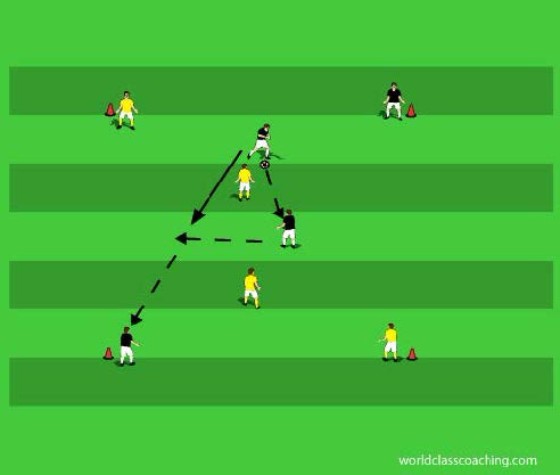
2v2+4 - 15x15 grid
Play 2v2+4 in a grid. Teams play to opposite corners as indicated in the diagram. Players passing to a target then take that player’s place at the corner and play continues. After scoring in one corner, the attacking team must work to the opposite corner. Target players cannot be used for support. This is a very fast-paced, demanding exercise that is very good for speed of play and also for encouraging a countering mentality. Players should be encouraged to look to play to the corner as soon as an angle is available and also to look to combine (1-2 and overlap) to imbalance their opponents.
Pairs passing with cues - ½ field
Players work in pairs. Two-touch passing to warm up. Explain that this session is built around organizing the team to counter-attack. Introduce each of the variations and cues below, allowing the players to practice each cue and reaction in isolation every few passes.
• the receiving player steps on the ball. Her partner immediately runs to the ball and the players change places before continuing.
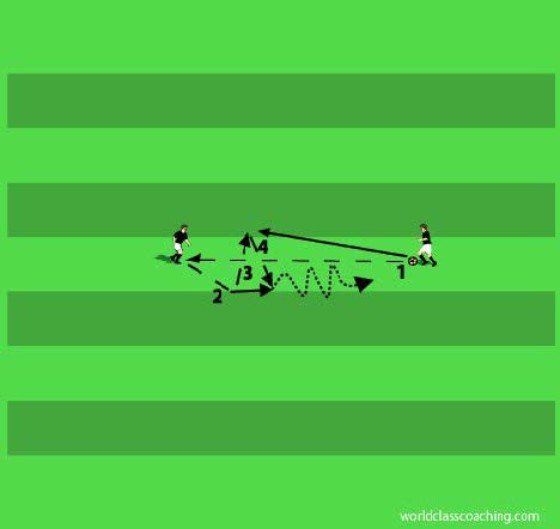
• the receiving player takes a short touch to one side and looks down (above). Her partner moves closer and to the opposite side and the pair complete a 1-2 before changing places.
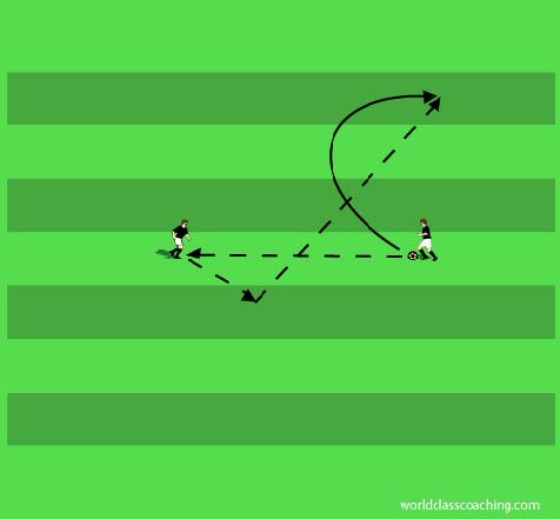
• the receiving player takes a long touch and looks up. Her partner spins off and runs away from the ball and she is played a long pass.
Once the players have rehearsed each of the cues, explain that the meaning behind each cue is related to the team in possession. If the player looks down (as in the first two variations), she is under pressure and her teammate must check to her to offer a passing option to release pressure. If the player looks up and takes a long touch, she has time and space to play and her partner should check away to create a longer pass and unbalance the opposing defense. Now that the players understand the meaning behind each of the three cues, send them back to train two-touch passing with each of the variations mixed in.
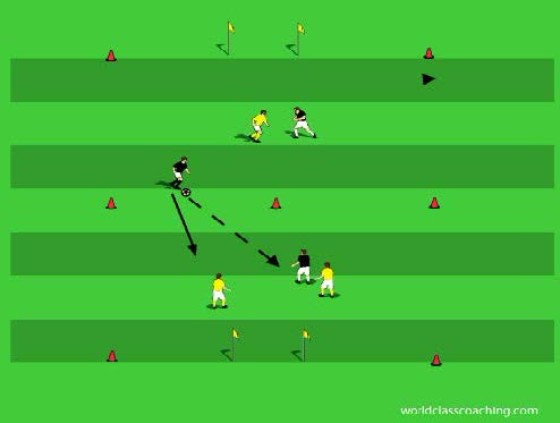
Cobra Strike - (2) 12X15 yard grids
Players are organized in groups of three. Play on fields divided into two 12X15 yard grids. Each team plays two defenders and one forward. The forward cannot leave the front grid and the backs can only go into the front grid if they play into the striker. No one is allowed to play goalkeeper in this exercise. Play for 10 minutes, rotating the attacking player in each grid. Then, institute a rule that the striker is limited to one touch and when one defender plays into the striker, the other must go forward in support of the attack (the player passing forward cannot go forward). This requirement gets all 3 players to think ahead and look for a third attacker in possession.
8v8 Game - ½ field
Play 8v8 on ½ field. Encourage players to look to play forward early and then move in support of the pass.


